European Hedgehog Mortality - Parasites & Diseases
Hedgehogs, like most wild mammals, are known to carry various parasites including a range of fleas, ticks, mites, myiasis (where flies lay eggs around wounds), fungal infections, parasitic worms, protozoa (esp. Cocidia and Toxoplasma), bacterial and viral infections. Tumours have been recorded in hedgehogs (e.g., squamous cell carcinoma, and tumours of the colon and pituitary gland). There is a single record of a skin tumour from E. concolor listed by Walter Poduschka in his 1981 paper to Kleinteir Praxis, but I'm not aware of any similar records for europaeus.
Note: If a hedgehog is out during the daytime away from cover and acting in a “drunken” manner, is “sunbathing” or listless, it will require urgent veterinary attention. Additionally, hedgehogs may hold their spines/jackets high on their backs, a behaviour rescues refer to as “walking high”, indicating discomfort or a high parasite burden, again requiring veterinary intervention.
Syndromes and disease
Hedgehogs have a propensity for eating almost anything and will readily consume high fat foods (e.g., cat food, processed meats, etc.) put out in gardens and if offered in captivity. Hedgehog metabolism is geared to the digestion of high protein invertebrate prey and unrestricted access to high-fat foods can result in hepatic steatosis (fatty liver disease), obesity and some of the coronary complications seen in humans with similar diets.
Eating too much fat is not the only dietary issue affecting hedgehogs. We've recently started to suspect that the over-consumption of food with a low calcium-to-phosphorous ratio, such as peanuts and mealworms, can result in inflammation and metabolic bone disease, an umbrella term for a variety of conditions including bone thinning and osteoporosis. In the last few years, wildlife hospitals and hedgehog carers have started seeing an increase in the number of hogs admitted with apparently weak/fractured bones. Bone density can only be confirmed via x-ray, which is not always an option, but affected animals can often only shuffle/slide around owing to the pain caused by microfractures in the bones and joints and deformities in the joints themselves.
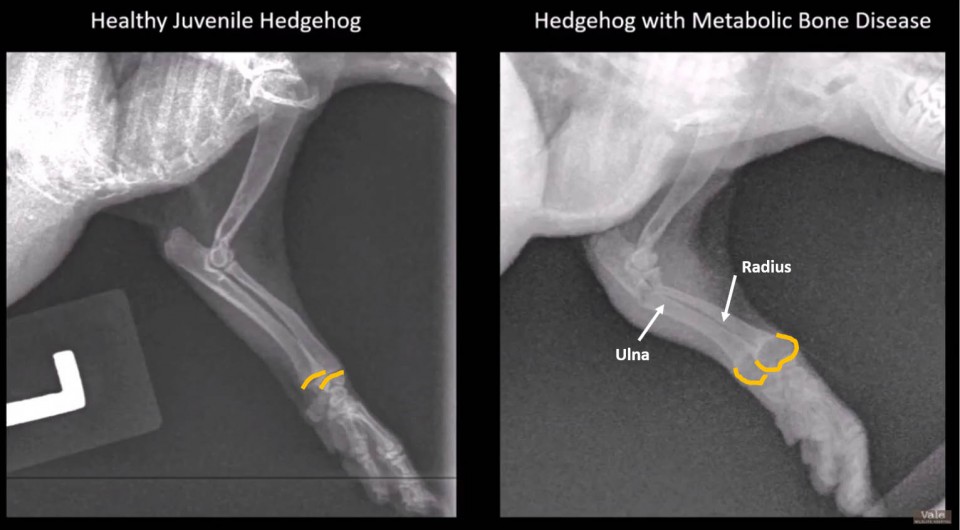
Calcium is an essential nutrient for bone metabolism and structure, as well as for general cell function, and when there's too little circulating in the bloodstream it can be fatal. Consequently, when calcium levels fall too low, the body responds by releasing parathyroid hormone, which stimulates the production of vitamin D to increase the absorption of calcium through the gut. In addition to boosting dietary absorption, however, vitamin D also tells the bones to give up some of their calcium. The result is that calcium is extracted from the bones, leaving them weak and brittle. If this is only temporary and relatively mild, such as where deer undergo this osteoporosis while regrowing their antlers, it can be redressed. If the situation isn't corrected, however, the calcium isn't replaced and the bone remains prone to fracturing and irreversible deformity. Recalcification of the bones from supplementing the diet with calcium is a possibility, but it is a slow process and many hogs arrive at rescues too late.
Calcium and phosphorous need to be consumed in a reasonably balanced ratio, because the latter impairs the absorption of the former—in other words, too much phosphate (the form in which most phosphorous is found in the environment) in the diet can stop the absorption of calcium. Typically, a calcium-to-phosphate ratio of 1.1:1 is fine (so fractionally more calcium per milligram of phosphate), although several hedgehog rescues currently recommend 2:1, and we now think that wild hedgehogs are presenting with metabolic bone disease because of the high phosphate diet they're coming across in our gardens.
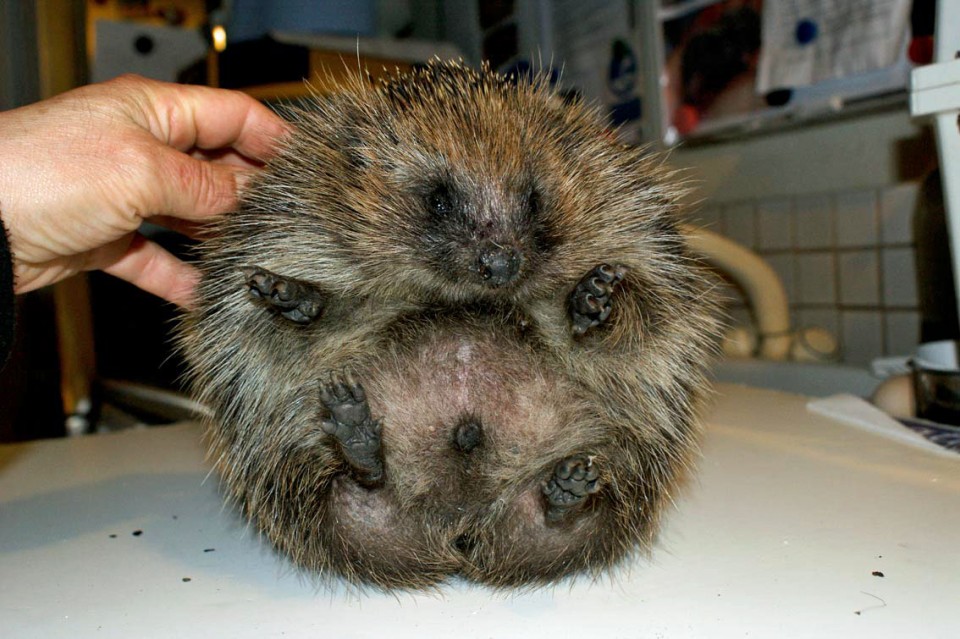
While it's great that people want to help their local hogs, it's important that the correct food is being offered. Unfortunately, mealworms, peanuts and sunflower hearts are popular choices, but all three are high in phosphate and low in calcium. Average values vary according to brand (and sometimes the method used to assay them), but mealworms generally seem to have a calcium-to-phosphate ratio of around 1:10 - some have up to 1:30 (i.e., up to 30-times more phosphate than calcium. Peanuts and sunflower hearts are less extreme, at around 1:7, but still contain significantly more phosphate than calcium. If you intend to feed hedgehogs in your garden, meaty wet cat/dog food is fine, as is complete kibble or specially formulated hedgehog food. Please don't offer mealworms, peanuts or sunflower hearts, even just a few as a “treat”.
Hedgehogs may also suffer from conditions known as 'balloon syndrome' and “pop-off”. Balloon syndrome, or more accurately subcutaneous gaseous emphysema, is a condition where the hedgehog's body swells (in larger individuals, to the size of a football) and the legs splay out, preventing the animal from walking; it's caused by an injury that leads to a build-up of gas under the skin and, if left untreated, the hedgehog will eventually suffocate. The treatment of balloon syndrome involves removing the air with a syringe, followed by administration of antibiotics. Pop-off, by contrast, is a condition where the spines ride up over the back, exposing the feet and tail; it is prolapsing of the orbicularis muscle and prevents the animal from curling up. It is usually caused by trauma, such as the hog struggling to get free when caught, although it has also been linked to a thiamine (vitamin B) deficiency in hoglets. In young hogs, the muscle may slip back into place on its own when they're warmed up, while it almost always requires veterinary attention (under general anaesthetic) in adult animals. Spines may also appear to “ride up” on the back in cases of spondylitis, an inflammatory condition that can result in some of the vertebrae fusing together - this may also result in the hedgehog presenting with a waddling gait.
The syringe feeding of hoglets can lead to bloat; air is introduced into the stomach via the syringe and this can be fatal if left untreated. Gill Lucraft of Hedgehog Bottom Rescue in Berkshire tells me that, very rarely, adults present with something that looks like bloat but is actually a ballooning of the stomach, which can only be treated by a vet. In rare cases, hoglets may exhibit a condition colloquially referred to as “failure to thrive”, where the animal fails to grow. In mice, this condition appears to be caused by the GLI gene, which affects the development of the colon, but to the best of my knowledge it has never been studied in hedgehogs and cases are rare.
In hot, dry weather hedgehogs may show signs of dehydration and/or starvation. Indeed, Anni Ratuio and her colleagues recorded starvation as accounting for just over half of all the “natural deaths” in their sample. The spines being slow to respond when brushed is a sign of dehydration in hedgehogs, as is a reluctance to curl up or “sunbathing” behaviour. Work on the hedgehog population in the Outer Hebrides by Digger Jackson identified some females that appeared to have died from exhaustion resulting from the demands of raising a litter of hoglets.
At the end of 2023, a small male hedgehog was brought into Tiggywinkles Wildlife Hospital in west Buckinghamshire having been found too small to hibernate. After a couple of months in their care, the hog started having issues eating and was drooling. Assessment by their veterinary team in March 2024 revealed that four deciduous teeth had not fallen out when the permanent incisors had started growing in, affecting the growth of the hog's other teeth and causing the symptoms. Once the vet removed the deciduous teeth the hedgehog was able to eat again and resumed normal activity. We don't know how often such dental abnormalities occur in the wild, although there have been several hedgehog recently received by rescue centres suffering from brachycephaly (i.e., were pug-nosed), which can result in feeding and breathing issues, and the Royal Veterinary College has recently started collecting data on this condition.
External parasites
Hedgehogs have an undeserved reputation as carriers of fleas and are frequently blamed for giving their fleas to dogs. The first point to make is that hedgehog fleas (almost invariably Archaeopsylla erinacei, although others are occasionally found, including e.g., Xenopsylla, Nosopsyllus, Ctenocephalides and the mole flea Hystrichopsylla talpae) appear to be host-specific. In other words, hedgehog fleas can only breed, and hence complete their lifecycle, on hedgehog suggesting that even if a few “jumped ship” on to a dog, they're unlikely to survive long. Similarly, suggestions that hedgehogs are flea-prone, either because they cannot groom their spines, or because they need their fleas are unfounded. There is also no truth to the widely-cited rumour that removing a hedgehog's fleas will kill it. Hedgehogs can easily contort their bodies to groom their spines and rescue centres routinely de-flea the few hedgehogs that do arrive with a flea burden with no adverse effects.
Hedgehog fleas are orangey-red in colour, large by flea standards (typically 3mm long) and are commonly found in nests, where they have been known to survive the hedgehog's hibernation. Most hedgehogs will carry some fleas and they generally won't cause the hedgehog more than periodic discomfort (itching), although some individuals can become infested. One count in Sweden during the early 1970s, found an average of 130 per animal, varying with season, age and sex and, in his New Hedgehog Book, Pat Morris wrote:
“It is very unusual to find one with no fleas on it and sometimes there may be up to 500 on a single animal. What makes this appear even worse is the fact that the coarse hair and widely spaced spines do nothing to hide the fleas from our horrified gaze.”
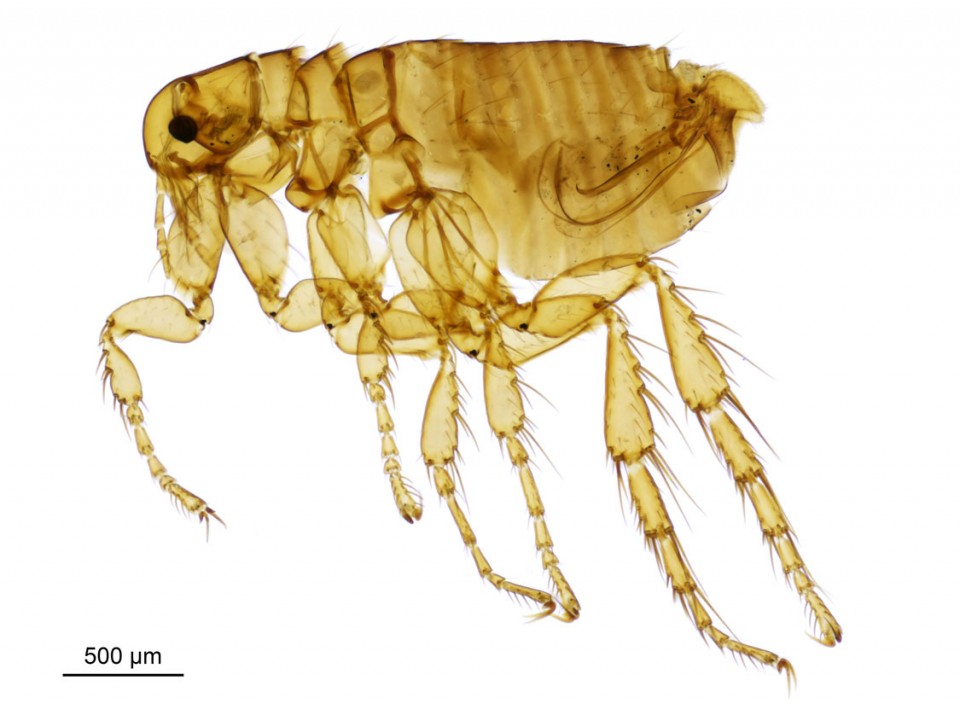
In The Complete Hedgehog, Les Stocker wrote that the “average” hedgehog has about 100 fleas, while there may be as many as 1,100 in extreme cases - Stocker also noted that the skin on a hedgehog's back is very thick and insensitive, perhaps explaining why they seem largely unconcerned by their parasite burden. Hedgehog carers typically note, however, that comparatively few hogs brought to them present with fleas. Indeed, Gill Lucraft, manager of Hedgehog Bottom, a rescue charity in Berkshire, tells me that in 2016 they admitted 722 hedgehogs, only four of which had fleas. Toni Bunnell's observations suggest the same low incidence of flea and that; has not changed in the past three decades. It should be noted, however, that the situation may be changing and in 2022 several rescue centres reported an increase in flea burdens, and fleas more resistant to standard treatments, than in previous years. During the summer months, hedgehogs may occasionally be found with a brown gooey substance on their spines and, assuming there are no obvious wounds, I have heard suggestions that this is probably blood excreted by their fleas, although I've come across no empirical evidence for this. Interestingly, New Zealand hedgehogs don't suffer with A. erinacei, but apparently pick up local flea species and are more prone to mite infestations than their British conspecifics.
Ticks, typically Ixodes hexagonus, and mites are also common parasites of hedgehogs. Generally, a hedgehog will have a few ticks, but individuals can present with heavy tick-burdens and it is not unusual for hedgehog carers to have to remove 20 or more before starting treatment. St. Tiggywinkles in Aylesbury have removed 153 ticks from one juvenile hog, while Hedgehog Bottom rescue removed 218 ticks from a juvenile male hedgehog admitted in July 2017 and, in August 2023, Whitby Wildlife Sanctuary removed a staggering 1,242 from an adult male. Numbers can also build up in nests and a study of one in the 1930s counted 72 adult ticks, 314 nymphs and 412 larvae. Such very heavy tick burdens can result in the hedgehog becoming anaemic, while clumsy attempts by well-meaning members of the public to remove ticks can cause the tick to regurgitate the blood, resulting in the hedgehog suffering blood poisoning. Ticks must be twisted out of the skin with a commercial tick-twister or lasso. The use of tweezers or pliers can either break the body, leaving the head embedded in the skin, or apply pressure to the abdomen that forces blood back into the host. Smothering the tick with Vaseline, oil and so forth, or burning it can also cause regurgitation.
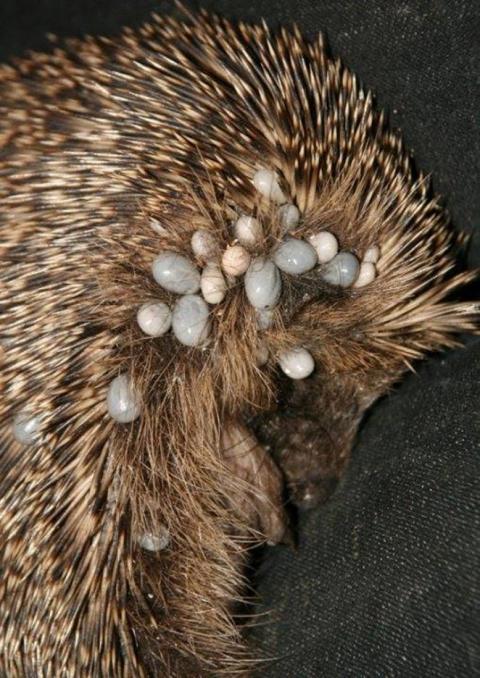
There is a curious discrepancy in that it tends to be female ticks found on the hedgehog's body, with males often remaining in the nests. The ticks also appear to have a fairly predictable feeding cycle. A series of lab studies by Freie Universität Berlin biologist Franz-Rainer Matuschka and colleagues found that ticks detached from their hedgehog host during the scotophase (i.e., when it gets dark), becoming replete during the late evening and early morning hours; this means they drop off while the hedgehog is out foraging. This may assist ticks with dispersing outside the nest, but it raises the question of how ticks find their next meal - do they just sit and hope another hog wanders past?
Interestingly, a detailed study by Hull biologist Toni Bunnell has revealed a strong correlation between hedgehog health and tick burden; i.e., sick animals consistently had more ticks than healthier ones. Moreover, in a fascinating paper to the Journal of Chemical Ecology during 2011, Bunnell and her co-workers report that ticks were attracted to the smell of sick hedgehog faeces.
The biologists found that ticks were attracted to a chemical (called indole) that gives faeces their characteristic smell. Curiously, when indole was added to healthy hog scat, however, the ticks didn't find it attractive, indicating that the indole reacts with other chemicals in the scat of sick animals to attract these parasites. The researchers suggest that ticks may choose their host based on the odour of their faces, thereby potentially reducing the likelihood that they'll find a healthy host whose immune system may put up more of a fight! Other ticks found, generally less frequently, on hedgehogs include Dermacentor, Haemaphysalis and Rhipicephalus.
Infection with mites, particularly Caparinia tripilis in Europe and New Zealand, can cause mange in hedgehogs; the result is a loss of hair and spines and eventual death. Sarcoptes and Notoedres mites have also been recorded from hedgehogs, but are generally uncommon. Demodex erinacei infect hair follicles of European hedgehogs, but generally do not cause harm and are less common than Sarcoptes. In her analysis of hedgehogs brought to her rescue centre in York, Toni Bunnell observed that 6% had sarcoptic mange and 1% demodectic mange. Generally, prevalence of mange in British hedgehogs appears to be about 10%.
In Hedgehogs, Nigel Reeve describes how myiasis (fly-strike) is a common and distressing illness in hedgehogs, occurring even in wounds of otherwise healthy animals. Essentially, myiasis (from the Greek myia, meaning “fly”) occurs when flies lay clusters of eggs in wounds or around the nose, eyes, ears, genitals or anus - the eggs hatch and the maggots begin consuming their host. In Europe, such infections are often caused by Lucilia blowflies.
Fungal infections are fairly common in European hedgehogs and, while various species have been found (e.g., Candida albicans, Rhodotorula, Torulopsis, Emmonsia, Histoplasma, etc.), ringworm is most prevalent. Ringworm in hedgehogs is a rather complex disease, not least trying to identify the species of fungi causing it (typically it'sTrichophyton erinacei), but many individuals carry it with few obvious signs of illness or distress. Indeed, even severely infected animals may continue to feed and behave normally. Nonetheless, symptoms in hedgehogs generally include spine loss, often in clumps with skin, and very dry, swollen ears. It is often cited that ringworm affects about one-quarter of Britain's hedgehog population, although this appears to be based on a study carried out by Pat Morris and Mary English published in the journal Sabouraudia during July 1969 and in which they wrote:

“Samples were taken from 203 animals and 39 (19.8%) were found to be infected. As discussed under 'Methods', this infection rate is likely to be an underestimate, and the overall total incidence of ringworm in British hedgehogs is probably between 20% and 25%.”
The results revealed males were more likely to be infected than females, presumably owing to the boars being more aggressive during the breeding season. It seems that there may also be local/regional differences in incidence. Indeed, the same paper reported that about 44% of the hedgehogs found in Bushy Park in London presented with ringworm infection, while Sandy Smith and Mary Marples found the fungus on 45% of the 114 animals they assessed in New Zealand (where the population density was higher than the UK) during the early 1960s. In her 2001 paper to Lutra, however, Yorkshire-based biologist and hedgehog rehabber Toni Bunnell reported that 4% of hogs brought to her rescue had ringworm and this parasite was most common in nestlings. If higher infection rates are associated with higher density populations, then the incidence may similar be higher among urban hedgehogs, although we have no empirical data on this. Morris and English's data suggest that the fungus can remain viable in dry nests for up to a year, even when the nest is abandoned, implying nests can remain a potential source of reinfection.
Ringworm is typically host-specific, but there are cases where hedgehog ringworm has been contracted by carnivores and humans. In a short paper to Acta Clinica Belgia in 2008, for example, dermatologists at the University Hospital of Liège led by Claudine Piérard-Franchimont reported on three cases of dermatophytosis in a father and his two teenage children and their pet dog in south-east Belgium that appeared to be caused by infection with T. erinacei. It appears that the family rescued and rehabilitated a wounded hedgehog a couple of months earlier and this was presumed to be the source of infection.
Internal parasites
Hedgehogs are hosts for various parasitic worm species including nematodes, cestodes, trematodes and acanthocephaids. Lungworm (typically, Crenosoma striatum but also Capillaria erinacei) is sufficiently common among British hedgehogs, especially hoglets born in late summer or early autumn, that individuals taken in by rescue centres are routinely administered anthelminitic drugs to treat the infection. Lungworm manifests most obviously as a dry “rattling” cough, caused as the newly-hatch larvae are coughed out of the lungs and swallowed to be expelled in the droppings, and can be fatal if left untreated. The route(s) of lungworm infection in hedgehogs is unknown, but slugs and snails are intermediate hosts for the parasite and may be a significant source of infection. In many cases, a mild worm burden is to be expected and causes few problems, while heavy worm burdens can manifest medically.
In a short paper to the Journal of Zoology in 1988, Brian Boag and Paul Fowler reported the results of their autopsies on hedgehogs collected from Scotland and northern England during which they observed pathological changes in most of those with lungworm infection, although two individuals each contained over 2,000 Capillaria erinacei without showing any obvious symptoms of illness. Boag and Fowler concluded that Crenosoma striatum and Capillaria erinacei were the most common species of lungworm in the sample area, with Vampirolepis erinacei being less common. In their Finnish study, Rautio and her colleagues 79% of their sample had a lungworm (Crenosoma striatum) infection.
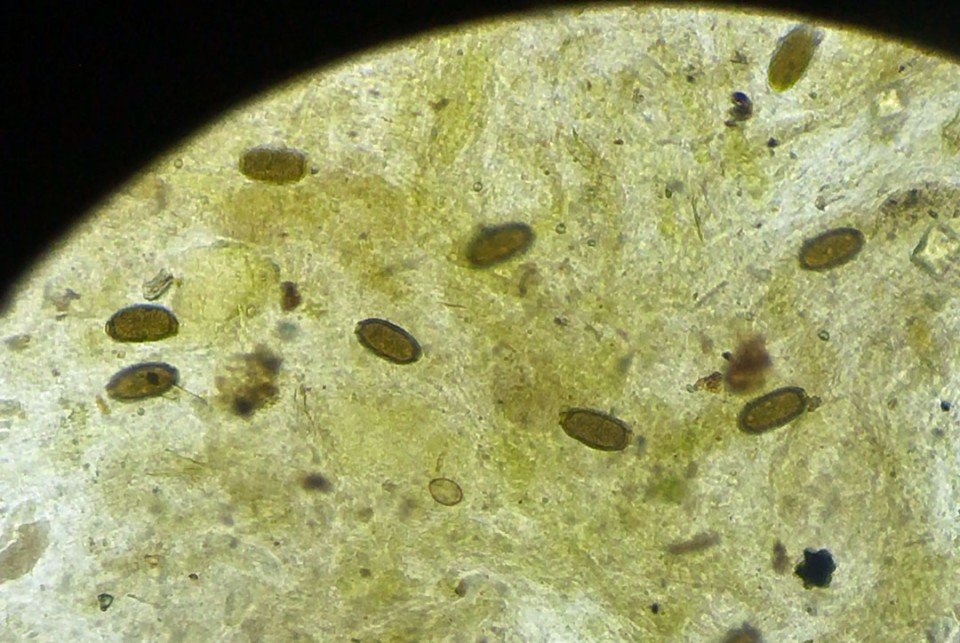
Intestinal flukes in hedgehogs include Brachylaemus erinacei, Agamodistomum pusillum, Euparyphium melis and Dollfusinus frontalis. A range of other nematodes (e.g., Physaloptera, Gongylonema, Gonglyonema and Trichinella) are also found in hedgehogs, with varying prevalence.
There are some data implying parasite burdens are higher in urban than rural hedgehogs, which is perhaps a reflection of higher densities and/or increased contact with other parasite-carrying species.
Infections & poisoning
Infections may result from fights between rival males or between courting males and females. These wounds may subsequently become infected with pathogenic bacteria or fly-strike. Hedgehogs are known to be susceptible to many protozoan and bacterial infections, including toxoplasmosis, sarcosystosis, coccidiosis, leptospirosis, colibacillosis, Pseudomonas and Salmonella. In their study of hedgehog mortality in Finland, published in Mammal Research in 2016, Anni Rautio and her team observed purulent gangrenous inflammation in the legs of 11 (29%) adult males in their sample—infections were frequently associated with small lesions (bites or scratches), possibly caused during fighting. Rautio and her team also found 57% were infected with Salmonella.
Viral infections such as foot-and-mouth, rabies (experimental infection only) and tick-borne encephalitis have also been documented, but remain rare. Tuberculosis has been recorded in hedgehogs from New Zealand, although there are haven't been any reports of the bacteria in hedgehogs from the UK. There is also a single case of clinical Lyme disease from a hedgehog in Europe, although other studies have shown hogs can carry the Borrelia burgendorferi bacteria without showing symptoms of Lyme disease.

Hedgehogs in Sweden have recently been identified as a potentially significant source of mecC-MRSA (Methicillin resistant Staphylococcus aureus). In a paper to Veterinary Microbiology in August 2017, Björn Bengtsson and his colleagues reported that mecC-MRSA was isolated from 64% of the 55 wild hedgehogs they autopsied, being present in three of the five geographically separated counties covered by their sample. In the paper, the veterinarians note:
“Our findings suggest that hedgehogs could be a reservoir for mecC-MRSA. In addition, similar spa-types of isolates from hedgehogs and isolates previously described in domesticated animals and in humans indicates transfer between these populations.”
The non-contagious pulmonary adiaspiromycosis (a fungal infection of the lungs) was diagnosed by Fernanda Seixas and colleagues at the University of Trás-os-Montes e Alto Donuro in a hedgehog found dead on a road in northern Portugal, but I'm aware of no similar reports from the UK. A curious “pop-eye” condition, more technically known as unilateral exophthalmos, was reported in a five-year-old female European hedgehog, presented to the Ohio State University Veterinary Teaching Hospital, by Vanessa Kuonen and colleagues in a 2002 paper to the journal Veterinary Ophthalmology.
In a series of papers to the journal Environmental Toxicology and Chemistry, a team of chemists from the University of Antwerp in Belgium have looked at the usefulness of spine analysis as a non-destructive (i.e., non-lethal) method of testing for pollutants in hedgehogs. The scientists found that levels of heavy metals (silver, arsenic, cadmium and lead) in spines were correlated with concentrations in soil, while concentrations of organochlorides (substances derived largely from pesticides, fuel combustion products and electrical insulation products - e.g., PCBs, DDT, HCB, HCHs and CHLs) in the spines closely matched those in the liver and muscle. This suggests that analyses of spines may provide biologists with a method of establishing pollution levels in hedgehogs (and potentially other mammals) without killing them or performing awkward tissue biopsies. Moreover, spine analysis could provide an invaluable tool for the study of environmental pollution. While this is exciting news in ecological terms, the results highlight the potential for hedgehogs to accumulate levels of toxins from their environment, the impact of which on their health is largely unknown.
Hedgehogs may also be at risk from poisons used to control rodents (rodenticides), slugs (see QA) and weeds (e.g., Paraquat poisoning is known in UK hedgehogs). In a paper to the journal Environmental Pollution during 2010, a team of biologists from Bristol University led by Claire Dowding found that two-thirds of the 120 hedgehogs they studied had traces of at least one rodent poison in their livers. The suggestion is that the invertebrates that form the bulk of the hedgehog diet pick up these rat/mice poisons by feeding off bait and the carcasses of poisoned animals. Hedgehogs may also be more directly exposed, given that they will feed on carrion. Either way, the study suggests only that hedgehogs are susceptible to accumulating these poisons, although the biologists found no direct evidence of lethal exposure. The authors note:
“Although exposure of hedgehogs to anticoagulants may be widespread, there is no evidence from our study that this commonly causes lethal poisoning. The post-mortem examination of the animals in our study did not identify any instances of haemorrhage that appeared consistent with rodenticide poisoning.”
More recently, Castleford Hedgehog Rescue in west Yorkshire reported having 10 rat poison deaths and eight rat trap victims in August 2023.
Other maladies have been documented less frequently. Vanessa Kuonen and colleagues at Ohio State University's College of Veterinary Medicine describe a carcinoma (cancer) in the left lacrimal duct of a five year old female hedgehog in a paper to Veterinary Ophthalmology, while Widden and colleagues report a fatal herpesvirus infection of two nestling hedgehogs in the journal Veterinary Record and Glen Cousquer, at the RSPCA Wildlife Hospital in Somerset , notes that hedgehogs can be susceptible to verminous pneumonia in a paper to the same journal in 2004.
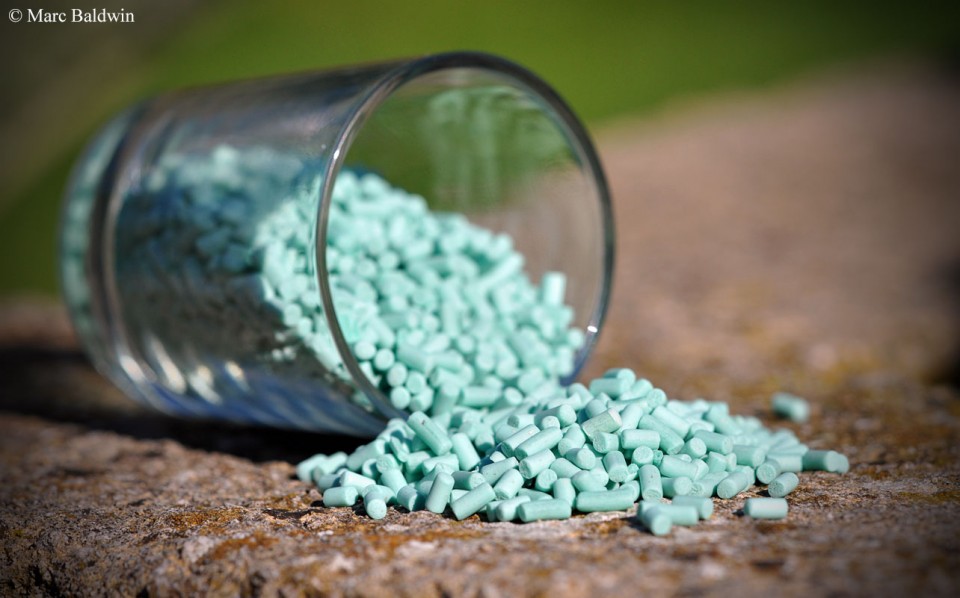
The topic of hedgehog parasites in relation to humans (both human health and impact on livestock) is discussed at greater depth in the Q/A section, but it is worth quickly mentioning that humans may be able to pass some infections on to hedgehogs. In a paper to the journal EcoHealth in December 2015, a team from the Zoological Society of London and Public Health England, led by Lydia Franklinos, report on having isolated the Streptococcus pyogenes bacteria from an adult male hedgehog found dead in garden in Northumberland during June of the previous year. S. pyogenes is carried by many people and, in most cases, it does no harm; but it can cause a range of conditions, from strep throat to the streptococcal toxic shock syndrome that killed Muppets creator Jim Henson in 1990, at the age of 53. Franklinos and her team noticed that the hog was in poor condition, suffering from severe gum disease and a tooth root abscess that was the most likely entry point for the bacteria. They also confirmed that the bacterial infection caused the hedgehog's death. The researchers concluded that:
“Whilst we cannot exclude that the hedgehog contracted S. pyogenes infection from another (non-human) animal, such as a domestic pet or mastitic cow, the rarity of described non-human infections indicates that this is unlikely. We postulate that infection in this case occurred due to anthroponotic transmission.”
In other words, they consider it most likely that a human passed on the bacteria to this hedgehog. This is a reminder that people should take basic hygiene precautions when preparing food for hedgehogs visiting their gardens.